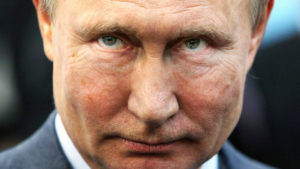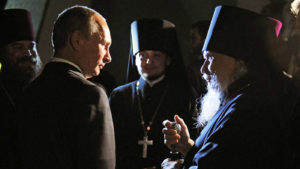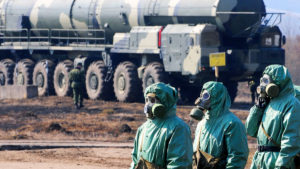The 11th anniversary of the war in Syria passed earlier this month with little notice, eclipsed by Russia’s invasion of Ukraine. But the two wars are intimately connected. It was Russia’s entry into the Syrian war in 2013, at the invitation of the United States, that set the stage for its initial incursions into Ukraine the following year; the prequel to the full-scale invasion last month.
A year into the war in Syria, in 2012, President Obama declared that chemical weapons attacks there were a red line that, if crossed, would trigger “enormous consequences”. When the White House concluded “with high confidence” that Bashar al Assad’s forces were responsible for a Sarin attack that killed 1,429 people in the Damascus suburb of Ghouta, Obama was placed in a bind. If he didn’t do something, it would look like a capitulation. But any reprisal risked drawing the US into another Middle Eastern war and jeopardising the nuclear deal with Iran that was the linchpin of Obama’s foreign policy agenda. That was where Moscow came in.
Russia volunteered to oversee the dismantling of Syria’s chemical weapons program in a deal that would allow the White House to save face without threatening its pivot towards Iran. It might have seemed like a win-win proposition. But Russia was hardly neutral: Moscow was both a key ally of Iran and of the Assad dynasty, and saw its role in the Syrian war as the way to acquire its long-sought-after naval base on the eastern Mediterranean. “Syria mattered to Russia because it mattered to Iran,” explains Levant analyst Tony Badran. Making Moscow a “peacemaker” meant that, “for all the moralising rhetorical barrages against Russia’s support for the brutal Assad, Putin remained [Obama’s] principal partner in the Syrian arena”.
American rhetoric on Syria was anti-Assad and pro-democracy. It emphasised funding “moderate rebel” groups fighting against the government while protecting humanitarian interests and pushing for a negotiated end to the war. But those goals were incompatible with the other US aim, which was to protect the Iran deal at all costs, a goal which, as Obama put it in 2015, “allows those who are allied with Assad right now — allows the Russians, allows the Iranians to ensure that their equities are respected”.
Normally, wars end when one side gives up or the parties reach a compromise that spares them further losses and satisfies enough of their interests to be worth taking. But whose interests were being served in Syria, where the US, Iran, Russia, Turkey, Israel, and the Gulf Arab states all played a role and had “equities” to protect?
Syria, the bloodiest war of the modern era, provides the perfect example of what can happen when a series of poorly considered but urgent-seeming interventions by outside powers turn a local conflict into an international battleground. Something remarkably similar is now happening in Ukraine. In Syria, it took roughly two years before the local dimensions of the conflict were overrun by flows of foreign fighters, money, and weapons pouring in across its borders. A smaller version has unfolded rapidly in Ukraine.
In Syria, American strategic incoherence — effectively supporting both sides — made the conflict more transactional and open-ended. Blurring the local stakes invited a greater number of outside countries and substate groups to enter the war and pursue their own interests, creating a seemingly intractable multiparty conflict that was eventually settled through Assad’s Russian-backed campaign of brutal attrition war. It also emboldened Russia, which recognised that by treating Syria as a bargaining chip in its new partnership with Iran, Washington had set the precedent for a new era of great power conflict. Larger countries, it seemed, could carve out their claims from smaller nations with little fear of reprisal from the US led “international community”.
Less than a year after entering Syria, in February 2014, Russia launched its initial invasion into Ukraine targeting Crimea and the Donbas. Encountering little resistance, Russia stepped up its campaign in Syria, where in September 2015 Putin ordered airstrikes to rescue his embattled ally Assad. Of course Putin declared that these were “preventitive” measures, necessary to “destroy militants and terrorists on the territories that they already occupy, not wait for them to come to our house”. The same rhetoric is now used to justify the assault on Ukraine, another preventative war according to Putin, but this time a campaign of “denazification” and “demilitarisation”.
Play the full sequence out from 2013 to the present and Russia’s arrival as a “peacekeeper” in the Syrian war, becomes the first step in a series of expansionist military interventions that led to the invasion of Ukraine last month. The experience in Syria, which intensified after 2015, provided the Russian military with “priceless combat experience”, according to the Chief of the Russian General Staff, General Valery Gerasimov. Russia’s repeated attacks on anti-government rebels and Syrian civilians gave its military the chance to test out “more than 320 types of different weapons” Russian Defence Minister Sergei Shoigu bragged last year.
While Ukraine’s relationship with the US is far stronger than American ties to Syrian rebel groups, there are parallels. Washington has been dangling Nato membership in front of Kyiv for more than a decade, despite having no intention of ever bringing Ukraine into the alliance. The coy approach to Nato membership, in which no concrete steps were taken but the offer was never taken off the table, appeared to provide Ukraine’s political leadership with a symbolic chip to play while putting Moscow on the defensive. That strategy has backfired, as Ukraine’s President Volodymyr Zelenskyy recently acknowledged in an interview in which he said that Nato leaders told him directly, “you’re not going to be a Nato member, but publicly, the doors will remain open”. This in-between status had set the stage for Russia’s invasion, Zelenskyy said.
As deals such as the Nord Stream II pipeline — hence Europe’s energy dependency on Moscow — made the limits of the West’s commitments to Ukraine clear, the gamesmanship over Nato helped shift Putin onto the offensive in his pursuit of restoring a “Greater Russia”. In a replay of Syria, the US aggravated a conflict in which it has no immediate security interests by making promises it had no intention of keeping, causing Ukraine to dangerously overestimate the level of support it could count on in the event of a Russian attack. And once again, as the Biden administration tries to revive the Obama nuclear deal with Iran, Washington is using the same diplomatic doublespeak, sanctioning Russia for its role in Ukraine and warning about chemical weapons, while simultaneously offering the Russians sanctions relief to support the new Iran deal.
Meanwhile, foreign fighters are arriving to support both sides of the conflict. Ukrainian officials put the number of volunteers who had arrived in the country at 20,000 by the second week of March. Russia appears to be following the playbook used by Iran when it imported thousands of fighters from Hezbollah, and other Iranian-backed militias including the Fatemiyoun Army, made up of Shia ethnic Hazaras from Afghanistan, into Syria. Last Sunday, Chechnya’s Putin-loyalist authoritarian leader, Ramzan Kadyrov, posted a message online saying that he was in Ukraine and claiming to have deployed 10,000 Chechens soldiers to join him in the war there. There are additional reports, so far unconfirmed, of Russia hiring as many as 20,000 Syrian soldiers to fight Ukraine.
The numbers on both sides may be exaggerated, but thousands of foreigners pouring into Ukraine is one sign that the process of internationalisation that took years in Syria is happening now in mere weeks. As the conflict globalises it becomes harder to resolve — there are now many parties who feel they have a stake, instead of only two — and more susceptible to unpredictable escalations.
The size and fervour of the online war complicates matters further. Syria may have been the first “very online” war but the phenomenon has gone into overdrive in Ukraine. While twitter users splintered into bitterly opposed factions during the war in Syria, today Western social media is overwhelmingly pro-Ukraine. Some of this consensus is surely a result of the bans and blocks that silence “pro-Russian” accounts or those spreading misinformation; but the structural inducements to social conformity on social media play a role as well. As the emotional drive to support Ukraine automatically filters out “bad” news, it could have the perverse effect of discouraging a settlement. If Ukraine is really crushing the Russian invaders, as the generally optimistic accounts of the war on social media suggest (in contrast to the consensus among military experts), it reduces the incentives to make difficult compromises necessary to end the war.
At the moment it appears that the shared desire to avoid a siege on Kyiv, taking tens of thousands of lives while levelling the city, may create the pressure necessary for both parties find that settlement. But that scenario shouldn’t blind us to the parallels with Syria. The dangerous combination of Russian belligerence and US strategic incoherence is once again on display. But Ukraine carries a far greater risk of existential catastrophe because it involves a nuclear-armed Russia that is now at war, not only with other states but with decentralised digital networks.
The spontaneous boycott against all things Russian, which has included bans on ballet performances, university courses on Dostoevsky, and ordinary Russian civilians ability to use their bank cards, provides an example of a digital network in action. No individual organised the boycott or delivered instructions on what was to be banned. The boycott spread like other online “cancellation” campaigns, rapidly scaling up through the hyper-connectivity of digital social networks in a self-perpetuating phenomenon. These networks are borderless, leaderless, and operating at speeds far exceeding the capacity of individual actors to calculate their consequences.
“The legacy state is becoming a laser pointer,” the cryptocurrency pioneer Balaji Srinivasan observed. “The centralised entity points, the decentralised actors shoot.” But what if the laser pointer is wielded by a leader with an unsteady hand or an actor unsure of their goals? Could the state accidentally provoke a digital swarm attack that triggers a nuclear war?
“Prior sanctions regimes took years to get to the place that we got to in just a few days,” Ari Redbord, a former sanctions official in the US Treasury Department told me. He described the level of sanctions placed on Russia as “the nuclear option”. Redbord was only talking about official government measures. The “nuclear” economic strike of state sanctions only accounted for the official measures in what was a far larger economic attack on Russia that also includes the actions taken by dozens of private corporations. Once the first corporations such as Google, Mastercard, and Visa began taking steps to cut off and penalise Russia, it triggered a cascade with no clear goal or end point. Suddenly, companies which didn’t take action against Russia were seen as suspect. So far, little attention has been given to the consequences of the cascade but the global economy may be feeling the repercussions into the next century.
Sanctions have pushed Moscow closer to China while also threatening the dollar’s continued dominance. “We have entered a geopolitical depression that will have massive economic and financial consequences well beyond Ukraine,” says the economist Nouriel Roubini, in an essay pointing to the prospect of stagflationary recession and the increased probability of a hot war between major powers over the next decade.
There is reason to hope that the war in Ukraine will not be as drawn out or catastrophic as Syria. But even if settlement is swiftly reached, the impact of having disconnected the Russian economy from the rest of the globe will have a profound long-term effect on global stability. It would be a good time for great powers to step back from the abyss and recognise the danger of globalising local conflicts. There are only so many chances to learn that lesson in wars with nuclear powers.
Disclaimer
Some of the posts we share are controversial and we do not necessarily agree with them in the whole extend. Sometimes we agree with the content or part of it but we do not agree with the narration or language. Nevertheless we find them somehow interesting, valuable and/or informative or we share them, because we strongly believe in freedom of speech, free press and journalism. We strongly encourage you to have a critical approach to all the content, do your own research and analysis to build your own opinion.
We would be glad to have your feedback.
Source: UnHerd Read the original article here: https://unherd.com





